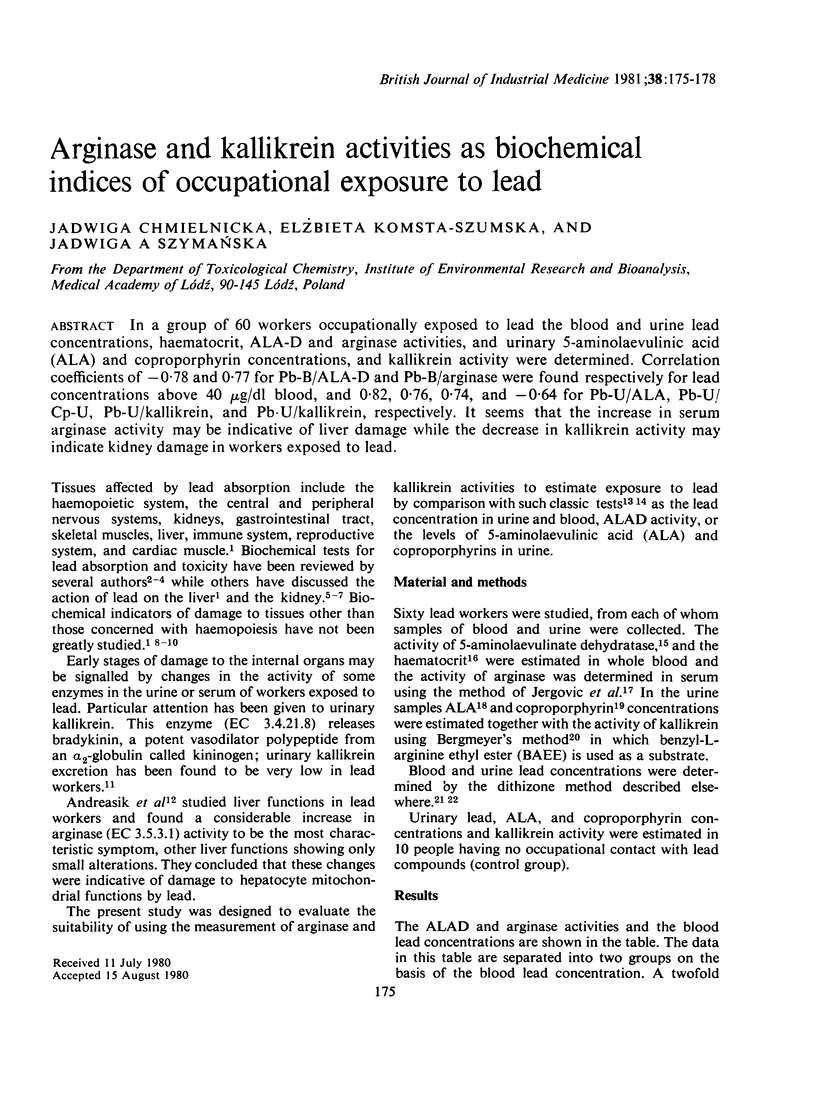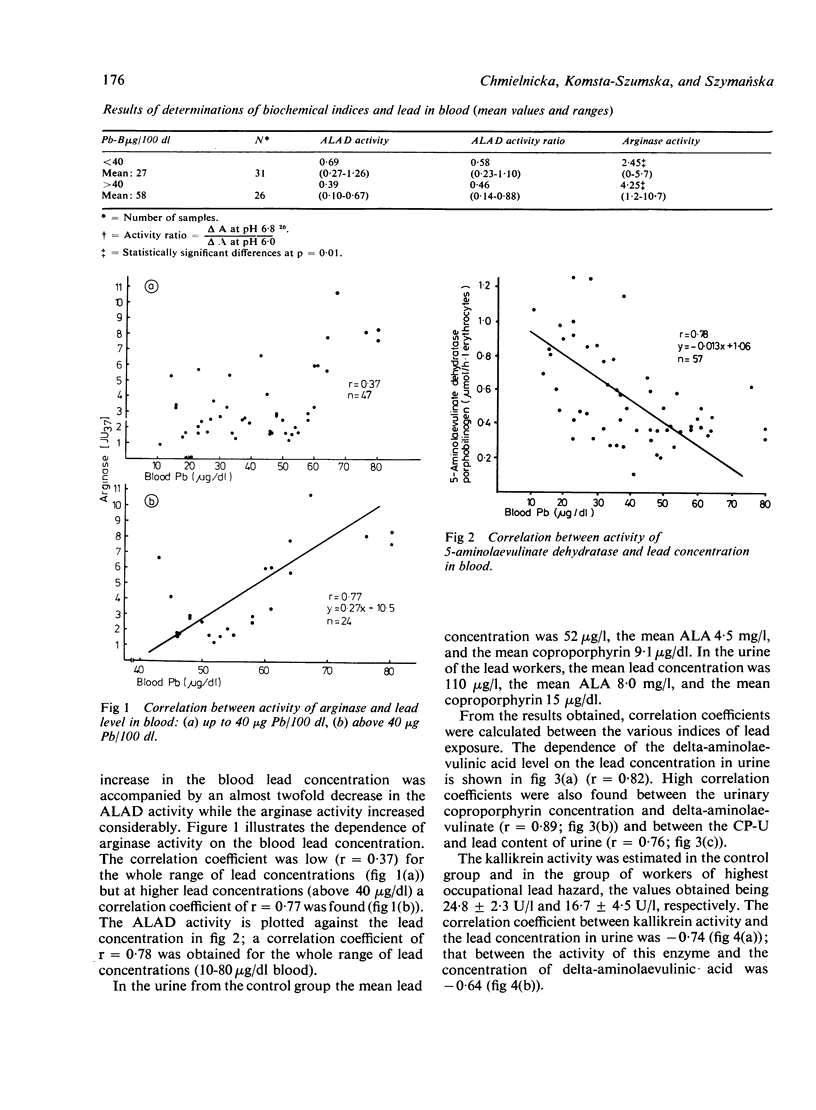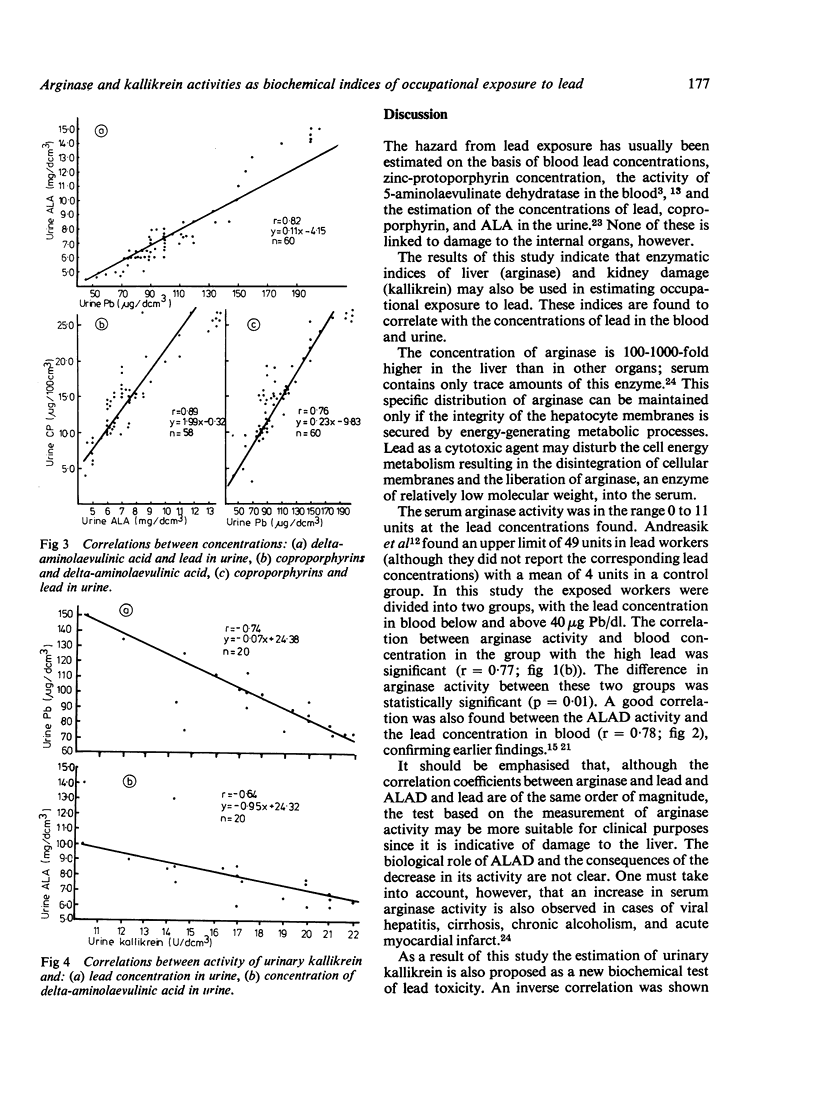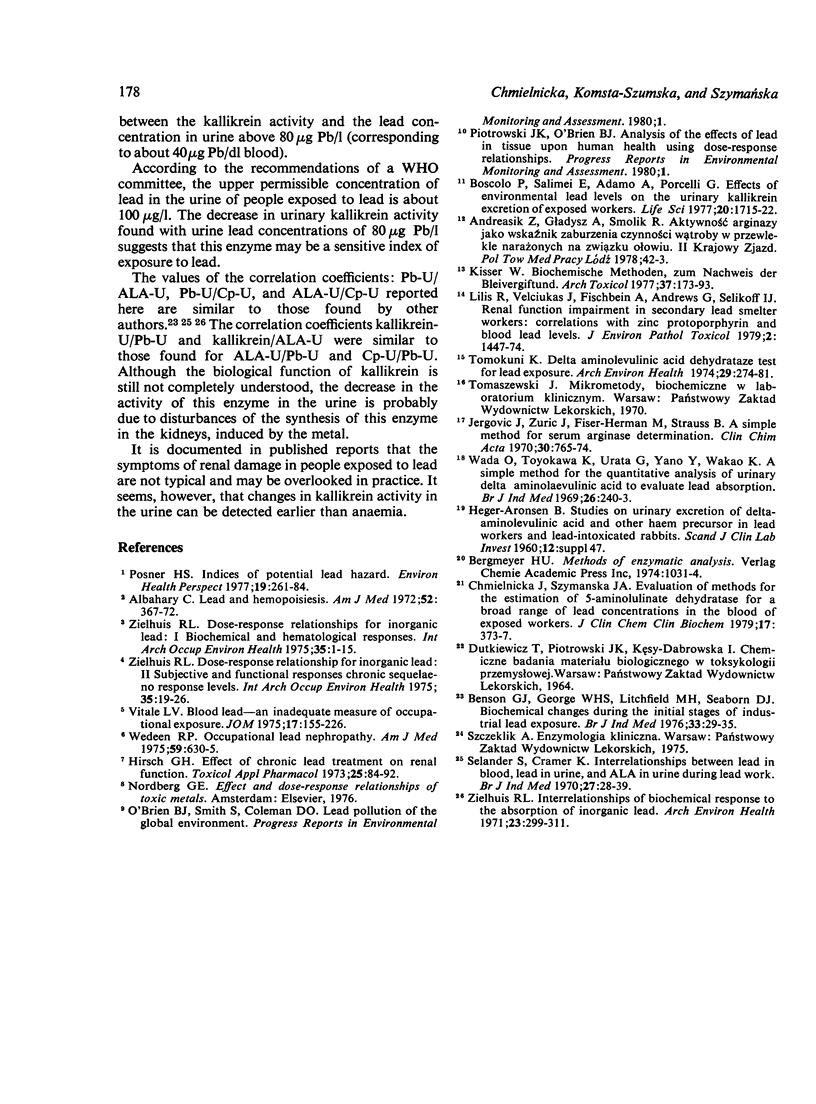Abstract
In a group of 60 workers occupationally exposed to lead the blood and urine lead concentrations, haematocrit, ALA-D and arginase activities, and urinary 5-aminolaevulinic acid (ALA) and coproporphyrin concentrations, and kallikrein activity were determined. Correlation coefficients of -0.78 and 0.77 for Pb-B/ALA and Pb-B/arginase were found respectively for lead concentrations above 40 microgram/dl blood, and 0.83, 0.76, 0.74, and -0.64 for Pb-U/ALA, Pb-U/Cp-U, Pb-U/kallikrein, and Pb.U/kallikrein, respectively. It seems that the increase in serum arginase activity may be indicative of liver damage while the decrease in kallikrein activity may indicate kidney damage in workers exposed to lead.
Full text
PDF



Selected References
These references are in PubMed. This may not be the complete list of references from this article.
- Albahary C. Lead and hemopoiesis. The mechanism and consequences of the erythropathy of occupational lead poisoning. Am J Med. 1972 Mar;52(3):367–378. doi: 10.1016/0002-9343(72)90025-3. [DOI] [PubMed] [Google Scholar]
- Benson G. I., George W. H., Litchfield M. H., Seaborn D. J. Biochemical changes during the initial stages of industrial lead exposure. Br J Ind Med. 1976 Feb;33(1):29–35. doi: 10.1136/oem.33.1.29. [DOI] [PMC free article] [PubMed] [Google Scholar]
- Boscolo P., Salimei E., Adamo A., Porcelli G. Effects of environmental lead levels on the urinary kallikrein excretion of exposed workers. Life Sci. 1977 May 15;20(10):1715–1721. doi: 10.1016/0024-3205(77)90347-2. [DOI] [PubMed] [Google Scholar]
- Chmielnicka J., Szymańska J. A. Evaluation of methods for the estimation of 5-aminolevulinate dehydratase for a broad range of lead concentrations in the blood of exposed workers. J Clin Chem Clin Biochem. 1979 Jun;17(6):373–377. doi: 10.1515/cclm.1979.17.6.373. [DOI] [PubMed] [Google Scholar]
- Hirsch G. H. Effect of chronic lead treatment on renal function. Toxicol Appl Pharmacol. 1973 May;25(1):84–93. doi: 10.1016/0041-008x(73)90166-x. [DOI] [PubMed] [Google Scholar]
- Jergović I., Zuzić I., Fiser-Herman M., Straus B. A simple method for serum arginase determination. Clin Chim Acta. 1970 Dec;30(3):765–774. doi: 10.1016/0009-8981(70)90273-1. [DOI] [PubMed] [Google Scholar]
- Kisser W. Biochemische Methoden zum Nachweis der Bleivergiftung. Arch Toxicol. 1977 Jul 19;37(3):173–193. doi: 10.1007/BF00355487. [DOI] [PubMed] [Google Scholar]
- Lilis R., Valciukas J., Fischbein A., Andrews G., Selikoff I. J., Blumberg W. Renal function impairment in secondary lead smelter workers: correlations with zinc protoporphyrin and blood lead levels. J Environ Pathol Toxicol. 1979 Jul-Aug;2(6):1447–1474. [PubMed] [Google Scholar]
- Posner H. S. Indices of potential lead hazard. Environ Health Perspect. 1977 Aug;19:261–284. doi: 10.1289/ehp.7719261. [DOI] [PMC free article] [PubMed] [Google Scholar]
- Selander S., Cramér K. Interrelationships between lead in blood, lead in urine, and ALA in urine during lead work. Br J Ind Med. 1970 Jan;27(1):28–39. doi: 10.1136/oem.27.1.28. [DOI] [PMC free article] [PubMed] [Google Scholar]
- Tomokuni K. Zeta-aminolevulinic acid dehydratase test for lead exposure. Arch Environ Health. 1974 Nov;29(5):274–281. doi: 10.1080/00039896.1974.10666587. [DOI] [PubMed] [Google Scholar]
- Vitale L. F., Joselow M. M., Wedeen R. P., Pawlow M. Blood lead - an inadequate measure of occupational exposure. J Occup Med. 1975 Mar;17(3):155–156. [PubMed] [Google Scholar]
- Wada O., Toyokawa K., Urata G., Yano Y., Nakao K. A simple method for the quantitative analysis of urinary delta-aminol evulinic acid to evaluate lead absorption. Br J Ind Med. 1969 Jul;26(3):240–243. doi: 10.1136/oem.26.3.240. [DOI] [PMC free article] [PubMed] [Google Scholar]
- Wedeen R. P., Maesaka J. K., Weiner B., Lipat G. A., Lyons M. M., Vitale L. F., Joselow M. M. Occupational lead nephropathy. Am J Med. 1975 Nov;59(5):630–641. doi: 10.1016/0002-9343(75)90224-7. [DOI] [PubMed] [Google Scholar]
- Zielhuis R. L. Dose-response relationships for inorganic lead. I. Biochemical and haematological responses. Int Arch Occup Environ Health. 1975 Jul 11;35(1):1–18. doi: 10.1007/BF01266323. [DOI] [PubMed] [Google Scholar]
- Zielhuis R. L. Dose-response relationships for inorganic lead. II. Subjective and functional responses - chronic sequelae - no-response levels. Int Arch Occup Environ Health. 1975 Jul 11;35(1):19–35. doi: 10.1007/BF01266324. [DOI] [PubMed] [Google Scholar]
- Zielhuis R. L. Interrelationship of biochemical responses to the absorption of inorganic lead. Arch Environ Health. 1971 Oct;23(4):299–311. doi: 10.1080/00039896.1971.10666005. [DOI] [PubMed] [Google Scholar]


